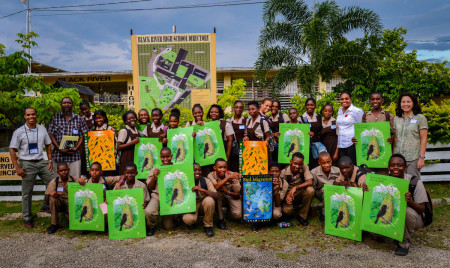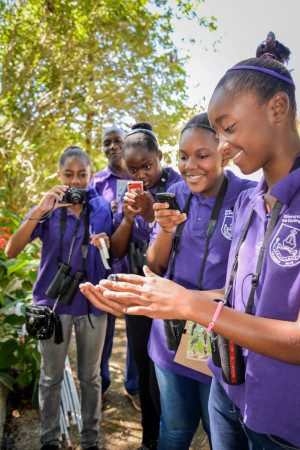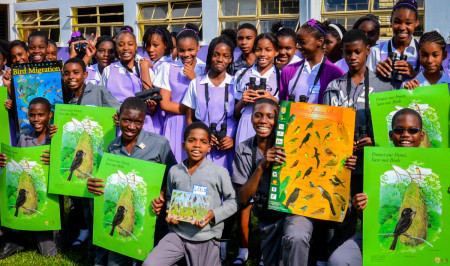
Last week 430 high school students from the parishes of Manchester, St. Elizabeth and Westmoreland participated in the second year of the first ever long-term study of knowledge, attitudes, and behaviors towards birds, and indeed the natural environment in the Western Hemisphere on the island of Jamaica.
A majority of these students had spent two days with four of the leading Ph.Ds. specializing in Caribbean bird and environmental conservation one year before, including Leo Douglas, Herlitz Davis, Luke Powell and Lisa Sorenson. These 2014 activities included both workshops and field-based programs using BirdSleuth Caribbean curriculum. Field activities focused on the Font Hill Nature Reserve (St. Elizabeth) an area threatened because of natural gas/peat fuel development and exploitation. On the field day students experienced first-hand scientists catching and studying migratory and native wild Jamaican birds with specially manufactured “mist-nets.” Students also witnessed forest destruction and marine turtle nests ravaged by invasive mongoose, and discussed the visible evidence of the rapid coastal-beach erosion within the context of climate change in the Caribbean.

This BirdsCaribbean project is funded and supported by the Smithsonian Migratory Bird Center, University of the West Indies and the Government of Jamaica to work in 13 randomly selected rural high schools. The multi-year program has been collecting data on the mechanisms through which Caribbean youth learn about the natural world, their beliefs about the positives or negatives of wildlife conservation, and how such beliefs might be improved through culturally-sensitive engaging programs and first-hand nature experiences.
The lead organization, BirdsCaribbean, is the largest single organization devoted to wildlife conservation in the Caribbean now in its 27th year of operation to promote Caribbean nature conservation. The Caribbean is ranked among the top five areas on the planet for biodiversity conservation – primarily because of the region’s unique native plants and birds and the many threats they face. Thirty-one birds are found on the island of Jamaica and nowhere else on the planet – a significant number more than any other of the region’s islands. A central part of the intervention will document knowledge and attitudes towards native Jamaican wild birds.
Dr. Leo Douglas, President of BirdsCaribbean and researcher in the Department of Geography/Geology at the University of the West Indies, Mona, describes the initiative as ground-breaking in its purpose and findings. Douglas said that while students were relatively well informed about the threat of rodent diseases, such as Leptospirosis, they were almost entirely unaware of the uniqueness or value of native plants and animals. “Almost all students entering the program had no idea that there were birds found only on Jamaica, or that birds were able to fly across the sea to get to Jamaica to spend the winter.” Douglas noted that he was pleased to learn that after one year many participating students had taken the initiative to bird-watch, conduct projects, or speak with family and friends about birds and their conservation, all on their own initiative.

Participating students described the program’s experiences as nothing but life altering in what they now knew and understood about the uniqueness, threats to, and values of plants and animals that were around them, especially birds.
One student from DeCarterate College described her experience this way:
“Hearing about what was happening to the birds and their habitats made me upset. Things like illegal trafficking – it reminded me of slavery; deforestation – imagine how beautiful it used to look; pollution – terrible! I hate it! In general I never knew much about birds. I can’t help thinking of all I have learnt and will learn.”
Post intervention in-depth interviews revealed that students generally bemoaned the lack of awareness about wildlife and nature conservation within the broader society and lauded the fact that they had been privileged to learn through the BirdsCaribbean bird-science experience program.
Douglas will follow the students for another two years to determine whether the observed changes in knowledge and attitudes are longer-term and what effects they may have on their personal and school-education choices, if any.

The study builds on the observance of a month-long region-wide festival focussed on endemic birds called the Caribbean Endemic Bird Festival (CEBF), celebrated for one month in spring by volunteer coordinators throughout the Caribbean. The theme for 2014 was “Why Birds Matter.” The purpose of the month-long festival is to increase public awareness of the region’s exceptionally rich and threatened bird life. After humble beginnings, the festival has grown consistently over the last 13 years and now attracts almost 100,000 Caribbean participants annually from 20+ island-nations. The CEBF has been described as an unprecedented initiative of regional unification about biodiversity, bird conservation and awareness by leading international conservation organizations, such as the United States Fish and Wildlife Service (USFWS).

One comment
Comments are closed.